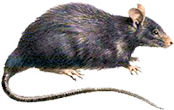
A typical roof rat is between 13 to 18 inches long from nose to tail. It is commonly known as the black rat, but is often
dark brown in color. Unlike other rats, their tails are longer than the length of their bodies and they have large ears.
Roof rats will nest in trees, woodpiles, garbage and plants, but they generally like inside high places, like attics. They
sometimes co-exist with sewer rats, though they like to be up high. They are good climbers and only need a hole the size of
a quarter to gain entry.
Roof Rats can have up to 8 litters per year each bearing 6-8 rats. They become sexually active 2-3 months after birth.
Roof Rats are most active one hour after sunset and one hour before dawn. They primarily consume fruits and nuts, although
they will eat anything. They tend to hoard food for consuming later. They are known for hollowing out citrus fruit in trees
or on the ground.
The roof rat is an introduced species of rat native to southern Asia.
It was brought to America on the first ships to reach the New World and has spread around the world. This rat is the same
species that carried the bubonic plague around the world and is also the reservoir host for murine typhus. Roof rats are the
worst rodent pest in the state of Florida and most abundant. The Norway rat (Rattus norvegicus) that is familiar to most
people is rare in Florida.
__________________________________________
|